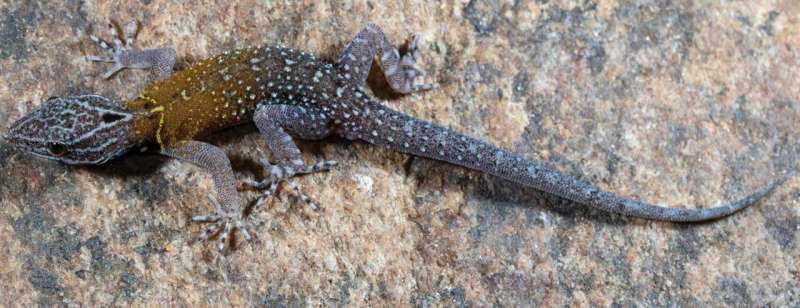A group of Indian researchers discovered a new species of gecko and decided to give it the... Vincent van Gogh’s name. In fact, the new critter has been named “Van Gogh’s dwarf star gecko” and given the scientific name Cnemaspis vangoghi. The discovery, made by the Thackeray Wildlife Foundation team, was published in the March issue of the scientific journal ZooKeys, in an article authored by Akshay Khandekar, Tejas Thackeray and Ishan Agarwal.
This species lives in India’s low-lying deciduous forests around the town of Srivilliputhur, joining the five known endemic vertebrates in the area. Geckos show strong sexual dichromatism, are diurnal (and particularly active during the cooler hours of the day) and are commonly found on rocks, buildings and occasionally trees. “This micro-endemism in low-lying species,” Thackeray Wildlife Foundation researchers write, “suggests that there are many more wonders to be discovered in India’s biodiversity hotspots.”

 Van Gogh’s dwarf starry gecko
Van Gogh’s dwarf starry gecko Van Gogh’s dwarf starry gecko
Van Gogh’s dwarf starry gecko Van Gogh
Van GoghThe little gecko was named in honor of Van Gogh because its coloration is reminiscent of one of the Dutch painter’s most famous paintings, The Starry Night.
It is a Cnemaspis, or small gecko, from a family widespread in Africa and Asia, small in size, with length from snout to mouth less than 34 mm. On its back it has characteristic granular scales, similar to Van Gogh’s stars, smooth to weakly keeled mixed with fairly regularly arranged rows of enlarged, weakly keeled conical tubercles. Males have the anterior half of the body ochre, a single central black dorsal ocellus on the neck, a white ocellus on the ventrolateral side of the neck and one on the throat posterior to the jaw, and have a dirty white belly with a dark throat, while females and juvenile specimens appear brown, juveniles also having a striation on the back.
Van Gogh’s dwarf star gecko has only been found in two close locations (Ayyanar Kovil and Settur Reserve Forest, both in the Meghamalai-Srivilliputhur Tiger Reserve) within less than 15 km distance in a straight line. The new species was recorded in seasonally dry tropical forest with a mix of evergreen and deciduous species between altitudes of 250-400 meters above sea level on the eastern slopes of the Western Ghats.
Individuals of the new species were observed active during the day (approximately between 8:30 a.m. and 2 p.m.) on rocks and tree trunks less than 2 meters above the base. Large numbers of individuals (more than 25 per hour) were observed at both locations, indicating a high abundance of this species in the area. At Ayyanar Kovil, some individuals were observed inactive, resting on the rocks during the evening and night (18:00-20:30). “An interesting case of micro-endemism in low-altitude species,” Ishan Agarwal called it.
 |
| In India discovered a small gecko named in honor of Van Gogh |
Warning: the translation into English of the original Italian article was created using automatic tools. We undertake to review all articles, but we do not guarantee the total absence of inaccuracies in the translation due to the program. You can find the original by clicking on the ITA button. If you find any mistake,please contact us.